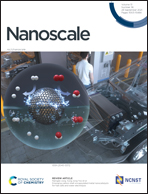Interlayer electron modulation in van der Waals heterostructures assembled by stacking monolayer MoS2 onto monolayer graphene with different electron transfer ability†
Abstract
Achieving tunable optoelectronic properties and clarifying interlayer interactions are key challenges in the development of 2D heterostructures. Herein, we report the feasible modulation of the optoelectronic properties of monolayer MoS2 (1L-MoS2) on three different graphene monolayers with varying ability in extracting electrons. Monolayer oxygen-functionalized graphene (1L-oxo-G, a high amount of oxygen of 60%) with a work function (WF) of 5.67 eV and its lowly oxidized reduction product, namely reduced-oxo-G (1L-r-oxo-G, a low amount of oxygen of 0.1%), with a WF of 5.85 eV serving as hole injection layers significantly enhance the photoluminescence (PL) intensity of MoS2, whereas pristine monolayer graphene (1L-G) with a work function (WF) of 5.02 eV results in PL quenching of MoS2. The enhancement in the PL intensity is due to increase of neutral exciton recombination. Furthermore, 1L-r-oxo-G/MoS2 exhibited a higher increase (5-fold) in PL than 1L-oxo-G/MoS2 (3-fold). Our research can help modulate the carrier concentration and electronic type of 1L-MoS2 and has promising applications in optoelectronic devices.



 Please wait while we load your content...
Please wait while we load your content...